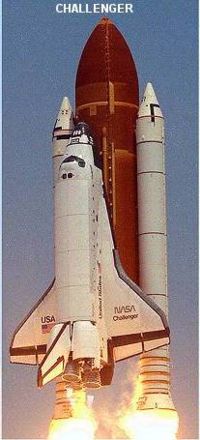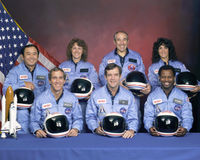Space Shuttle Challenger
2008/9 Schools Wikipedia Selection. Related subjects: Space transport
| Challenger OV-099 |
|
|---|---|
 Challenger launches, STS-51-L |
|
| OV Designation: | OV-099 |
| Country: | United States |
| Contract award: | July 26, 1972 |
| Named after: | HMS Challenger |
| First flight: | STS-6 April 4, 1983 – April 9, 1983 |
| Last flight: | STS-51-L January 28, 1986 |
| Number of missions: | 10 |
| Time spent in space: | 62.41 days |
| Number of orbits: | 995 |
| Distance travelled: | 25,803,939 miles |
| Satellites deployed: | 10 |
| Status: | destroyed January 28, 1986 |
Space Shuttle Challenger ( NASA Orbiter Vehicle Designation: OV-099) was NASA's second Space Shuttle orbiter to be put into service, Columbia being the first. Its maiden flight was on April 4, 1983, and it completed nine missions before breaking apart 73 seconds after the launch of its tenth mission, STS-51-L on January 28, 1986, killing all seven crew members. (For more on the Challenger disaster, see Space Shuttle Challenger disaster.) The accident led to a two-and-a-half year grounding of the shuttle fleet, with missions resuming in 1988 with the launch of Space Shuttle Discovery on STS-26. Challenger herself was replaced by the Space Shuttle Endeavour, which first launched in 1992.
History
Challenger was named after HMS Challenger, a British corvette which carried out a pioneering global marine research expedition in the 1870s.
Construction
The shuttle was constructed by using a body frame (STA- 099) that had initially been built as a test article. STA-099 was not originally intended for spaceflight, but NASA found that recycling it would be less expensive than refitting the prototype orbiter Enterprise (OV-101) to be spaceworthy, as originally planned.
Challenger (and the orbiters built after it) had fewer tiles in its Thermal Protection System than Columbia. Most of the tiles on the payload bay doors, upper wing surface and rear fuselage surface were replaced with DuPont white nomex felt insulation. This modification allowed Challenger to carry 2,500 lb (1,100 kg) more payload than Columbia. Challenger was also the first orbiter to have a head-up display system for use in the descent phase of a mission.
Flights and modifications
After its first flight, Challenger quickly became the workhorse of NASA's Space Shuttle fleet, flying far more missions per year than Columbia. In 1983 and 1984, Challenger flew on 85% of all Space Shuttle missions. Even when the orbiters Discovery and Atlantis joined the fleet, Challenger remained in heavy use with three missions a year from 1983-85. Challenger, along with Discovery, was modified at Kennedy Space Centre to be able to carry the Centaur-G upper-stage in its payload bay. Had STS-51-L been successful, Challenger's next mission would have been the deployment of the Ulysses probe with the Centaur to study the polar regions of the Sun.
Challenger's many spaceflight accomplishments included the first American woman, African-American, and Canadian in space, three Spacelab missions, and the first night launch and landing of a Space Shuttle. Challenger was also the first space shuttle to be destroyed in an accident during a mission. The collected debris of the vessel are currently stored in decommissioned missile silos at Cape Canaveral Air Force Station. From time to time, further pieces of debris from the orbiter wash up on the Florida coast. When this happens, they are collected and transported to the silos for storage. Because of her early loss, Challenger was the only space shuttle that never wore the NASA "meatball" logo.
 |
 |
| Challenger's rollout from Orbiter Processing Facility (OPF) to the Vehicle Assembly Building (VAB). Photo 1983-8-25 courtesy of NASA. |
Challenger while in service as structural test article STA-099. |
| # | Date | Designation | Launch pad | Landing location | Notes | Length of journey |
|---|---|---|---|---|---|---|
| 1 | 1983 April 4 | STS-6 | 39-A | Edwards Air Force Base | Deployed TDRS-1. First spacewalk during a space shuttle mission. |
5 days, 00 hours, 23 minutes, 42 seconds |
| 2 | 1983 June 18 | STS-7 | 39-A | Edwards Air Force Base | Sally Ride becomes first American woman in space. Deployed two communications satellites. |
6 days, 02 hours, 23 minutes, 59 seconds |
| 3 | 1983 August 30 | STS-8 | 39-A | Edwards Air Force Base | Guion Bluford becomes first African-American in space First shuttle night launch and night landing. |
6 days, 01 hours, 08 minutes, 43 seconds |
| 4 | 1984 February 3 | STS-41-B | 39-A | Kennedy Space Centre | First untethered spacewalk. Deployed two communications satellites, unsuccessfully. |
7 days, 23 hours, 15 minutes, 55 seconds |
| 5 | 1984 April 6 | STS-41-C | 39-A | Edwards Air Force Base | Solar Maximum Mission service mission. | 6 days, 23 hours, 40 minutes, 07 seconds |
| 6 | 1984 October 5 | STS-41-G | 39-A | Kennedy Space Centre | First mission to carry two women. Marc Garneau become first Canadian in space. |
8 days, 05 hours, 23 minutes, 33 seconds |
| 7 | 1985 April 29 | STS-51-B | 39-A | Edwards Air Force Base | Carried Spacelab-3 | 7 days, 00 hours, 08 minutes, 46 seconds |
| 8 | 1985 July 29 | STS-51-F | 39-A | Edwards Air Force Base | Carried Spacelab-2 | 7 days, 22 hours, 45 minutes, 26 seconds |
| 9 | 1985 October 30 | STS-61-A | 39-A | Edwards Air Force Base | Carried German Spacelab D-1 | 7 days, 00 hours, 44 minutes, 51 seconds |
| 10 | 1986 January 28 | STS-51-L | 39-B | Did not land (Planned to land at KSC) | Shuttle disintegrated after launch, killing all seven astronauts on board. Was to have deployed TDRS-B. | 0 days, 00 hours, 01 minutes, 13 seconds |
Loss of Challenger
Challenger was destroyed in the second minute of STS-51-L, the orbiter's tenth mission, on January 28, 1986, when an O-ring seal on its right solid rocket booster (SRB) failed. The O-rings failed to seal due to a variety of factors, including unusually cold temperatures. This failure allowed a plume of flame to leak out of the SRB and impinge on both the external fuel tank (ET) and SRB aft attachment strut. This caused both structural failure of the ET and the SRB pivoting into the orbiter and ET. The vehicle assembly then broke apart under aerodynamic loads.
